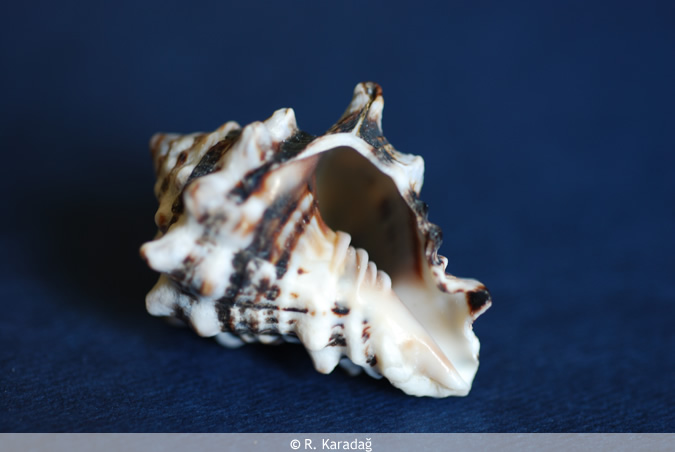Mediterranean sea, the coasts of Spain , Portugal , Morocco and the Canary Islands , depth of 2 130 m . Pliny suggests collection before the spring. Colour precursors are contained in the hypobranchial gland.
Historical Data
This ancient colour craft constituted one of the most complex of all industrial biochemical processes practiced in antiquity. Purple dyeing may have originated as early as about 4,000 years ago according to the archaeological record mentioned above, and perhaps the first discoverers of this enterprise were the Minoans of Crete. This supposition is based on the discovery of murex shells from that period at various Aegean sites, and also on wall paintings from that era.This Aegean theory of the discovery of purple dyeing, however, is inconclusive as it is based on indirect archaeological evidence. Although a molluskan purple paint pigment was discovered at Thera, no such purple residue has yet been found from an archaeological Aegean site in a dyeing context, such as on a vat fragment. It is a safe, politically correct archaeological course to take in stating that, whereas the Minoans and related peoples may have discovered this dyeing craft, history has nevertheless correctly credited the Phoenicians with, at the very least, perfecting the industry and producing royal purple-dyed textiles prized above all others.Pliny discusses the processing of the gland, or vein , and the dyeing stage in the following passage: Subsequently the vein of which we spoke is removed, to this salt has to be added, about a sextarius [Roman pint] for every hundred libras [Roman pounds]; three days is the proper time for it to be steeped, as certainly the fresher it [the extract] is the much stronger it is, it should be heated in a leaden pot, and with a single amphora [48 sextarii ] of water to every quinquagenas [fifty] libras [Roman pounds] of dye and kept at a uniform and moderate temperature by a pipe brought from a furnace some way off. This will cause it gradually to deposit the portions of flesh that are bound to have adhered to the veins, and after about nine days the cauldron is strained and a fleece that has been washed clean is dipped for a trial, and the liquid is heated up until fair confidence is achieved. A ruddy color is inferior to a blackish one.The fleece is allowed to soak for five hours and after it has been carded, it is dipped again, until it soaks up all the juice. Pliny then continues his narrative regarding the production of different hues of purple by mixing various snail species, and also discusses the robes bearing purple coloration as well as the extravagant prices of such purple dyeings. The Bible also mentions two closely related zoologically and chemically sacral dyeings, which modern chemical and historical research has also discovered to be produced from either the same or different Muricid sea snail species: the Biblical blue, tekhelet, and the Priestly purple, argaman.These two sacred molluskan dyes, together with the reddish scale-insect dye Sacral scarlet, shani are first mentioned in the Bible soon after the narrative that depicts the Exodus of the Israelites from Egypt. Biblical scholars have attributed this event to about 3,300 years ago, a period contemporaneous with an already well-established purple craft along the Mediterranean basin. Archaeological and historical evidence indicate that murex-dyeing died out in the eastern Mediterranean about a millennium and a half ago, some time towards the end of the Byzantine period in the 7th century AD, when new forces changed the geopolitical landscape of this region. As Bridgeman states: Under Muslim rule purple dyeing at Tyre and other places along what is now the Lebanese-Israeli coast ceased, hence the only surviving centers of purple manufacture were those of Asia Minor and Greece which remained under Byzantine Imperial control.The Islamic conquest of the Middle East began in about AD 632, and Muslim control over that area was established in approximately AD 660. Historical accounts note that the coastal residents were strong supporters of the Byzantine empire, and, with the oncoming conquest, emigrated from these areas to other parts of the realm that were still under Byzantine control. This created a population void, and the new Muslim rulers resettled these areas with those who were loyal to that new regime. Those fleeing Byzantine coastal residents undoubtedly included dyers of purple. Jewish sources, as noted by Herzog, also indicate that the dyeing of blue or violet tekhelet purple's relative ceased to exist at the shores of ancient Israel at about that period. Hence, it is a safe conjecture to conclude that murex dyeing died out along the shores of present-day Israel and environs about 1,350 years ago.

